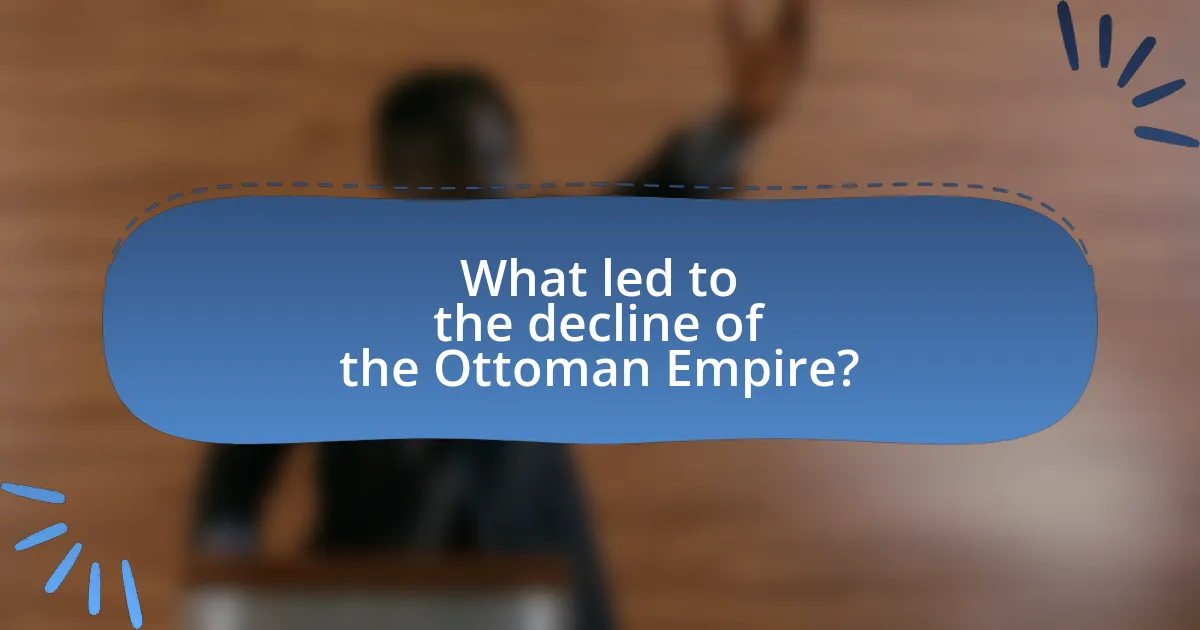The article examines the rise and fall of the Ottoman Empire, highlighting key factors such as military prowess, strategic location, and effective governance that contributed to its expansion. It discusses the empire’s military conquests, economic policies, and the significance of cultural and religious diversity in maintaining stability. Additionally, the article analyzes the internal and external pressures that led to the empire’s decline, including administrative corruption and European imperialism. Finally, it draws governance lessons from the Ottoman experience, emphasizing the importance of decentralization, cultural tolerance, and effective economic strategies for contemporary states.

What were the key factors in the rise of the Ottoman Empire?
The key factors in the rise of the Ottoman Empire included military prowess, strategic location, and effective governance. The Ottomans utilized advanced military tactics and technology, such as gunpowder weapons, which allowed them to conquer vast territories. Their strategic location at the crossroads of Europe and Asia facilitated trade and cultural exchange, enhancing their economic power. Additionally, the Ottomans implemented a centralized administrative system that promoted stability and integration of diverse populations, exemplified by the millet system, which allowed religious communities to govern themselves under their own laws. These factors collectively contributed to the rapid expansion and consolidation of the Ottoman Empire from the late 13th century onward.
How did military conquests contribute to the empire’s expansion?
Military conquests significantly contributed to the empire’s expansion by enabling the Ottoman Empire to acquire vast territories and resources. Through strategic military campaigns, the Ottomans captured key cities and regions, such as Constantinople in 1453, which served as a crucial gateway between Europe and Asia. This conquest not only expanded their geographical reach but also facilitated control over trade routes, enhancing economic power. The empire’s military prowess allowed it to dominate neighboring states, leading to further annexations and the establishment of a diverse multicultural empire that spanned three continents.
What strategies did the Ottomans employ in their military campaigns?
The Ottomans employed a combination of advanced military tactics, effective use of artillery, and strategic alliances in their military campaigns. Their innovative use of gunpowder weapons, particularly cannons, allowed them to breach fortified city walls, exemplified by the successful conquest of Constantinople in 1453. Additionally, the Ottomans utilized a highly organized military structure, including the Janissaries, an elite infantry corps that provided disciplined and loyal soldiers. They also engaged in psychological warfare, employing tactics such as feigned retreats to confuse and demoralize their enemies. These strategies collectively contributed to the Ottomans’ ability to expand and maintain a vast empire across three continents.
How did the acquisition of new territories influence governance?
The acquisition of new territories significantly influenced governance by necessitating the adaptation of administrative structures to manage diverse populations and resources. As the Ottoman Empire expanded, it incorporated various ethnicities and religions, leading to the implementation of the millet system, which allowed for a degree of autonomy among different religious communities. This system facilitated governance by enabling local leaders to maintain order and loyalty, thereby reducing the administrative burden on the central authority. Historical evidence shows that this approach not only helped in managing the complexities of a multi-ethnic empire but also contributed to the stability and longevity of Ottoman rule for several centuries.
What role did trade and economy play in the empire’s growth?
Trade and economy were crucial to the growth of the Ottoman Empire, as they facilitated wealth accumulation and territorial expansion. The empire’s strategic location along key trade routes, such as the Silk Road and maritime paths connecting Europe and Asia, enabled it to control and tax trade, generating significant revenue. This economic power allowed the Ottomans to fund military campaigns, expand their territories, and maintain a complex administrative structure. Additionally, the empire’s diverse economy, which included agriculture, crafts, and trade, contributed to its stability and resilience, further supporting its growth. Historical records indicate that by the 16th century, the Ottoman Empire was one of the wealthiest states in the world, largely due to its thriving trade networks and economic policies.
How did the Silk Road impact the Ottoman economy?
The Silk Road significantly enhanced the Ottoman economy by facilitating trade and commerce across vast regions. This trade route connected Europe, Asia, and Africa, allowing the Ottomans to control and tax the flow of goods such as silk, spices, and precious metals. The strategic location of the Ottoman Empire along the Silk Road enabled it to become a central hub for merchants, which increased revenue through tariffs and boosted local economies. Historical records indicate that during the 16th century, the Ottoman Empire’s wealth grew substantially due to its pivotal role in international trade, with the empire’s capital, Istanbul, becoming a bustling marketplace that attracted traders from various cultures.
What were the main economic policies implemented by the Ottomans?
The main economic policies implemented by the Ottomans included state control over trade, taxation systems, and agricultural reforms. The Ottoman Empire established a centralized economy where the state regulated trade routes and imposed taxes on goods, which facilitated revenue generation. The devshirme system also contributed to economic stability by ensuring a loyal administrative class that managed resources effectively. Additionally, land tenure reforms, such as the timar system, allocated land to military officers in exchange for service, promoting agricultural productivity. These policies were crucial in maintaining the empire’s economic strength and supporting its vast administrative structure.
How did cultural and religious diversity shape the empire?
Cultural and religious diversity significantly shaped the Ottoman Empire by fostering a system of governance that promoted tolerance and integration among various ethnic and religious groups. This inclusivity allowed the empire to maintain stability and cohesion over a vast territory, which included Muslims, Christians, and Jews, among others. The millet system exemplified this approach, granting autonomy to different religious communities to govern their own affairs, thereby reducing conflict and enhancing loyalty to the empire. Historical records indicate that this policy not only facilitated administrative efficiency but also encouraged economic prosperity, as diverse communities contributed to trade and cultural exchange, ultimately strengthening the empire’s longevity and influence.
What was the significance of the millet system in governance?
The millet system was significant in governance as it allowed the Ottoman Empire to manage its diverse population by granting religious communities a degree of autonomy. This system enabled various ethnic and religious groups, such as Christians and Jews, to govern their own affairs, including legal matters and education, under their own religious laws. The millet system facilitated social cohesion and reduced tensions among different groups, contributing to the stability of the empire. Historical evidence shows that this approach helped the Ottomans maintain control over a vast and diverse territory for centuries, as it fostered loyalty among the millets by respecting their cultural identities and practices.
How did cultural integration affect social cohesion?
Cultural integration significantly enhanced social cohesion within the Ottoman Empire by fostering a sense of shared identity among diverse ethnic and religious groups. This integration was facilitated through policies that promoted tolerance and coexistence, such as the millet system, which allowed various communities to maintain their own laws and customs while being part of the larger empire. Historical evidence shows that this approach led to relative stability and cooperation among different groups, as seen in the empire’s ability to govern a vast and diverse population for centuries. The successful blending of cultures contributed to a unified social fabric, which was essential for the empire’s longevity and administrative efficiency.

What led to the decline of the Ottoman Empire?
The decline of the Ottoman Empire was primarily caused by a combination of military defeats, economic challenges, and administrative inefficiencies. Key military defeats, such as the loss in the Battle of Lepanto in 1571 and the failed Siege of Vienna in 1683, weakened the empire’s territorial control and military reputation. Economically, the empire faced significant challenges due to competition from European powers, leading to a decline in trade revenues and increased debt. Additionally, administrative inefficiencies, including corruption and a failure to modernize governance structures, contributed to internal instability and loss of central authority. These factors collectively undermined the empire’s ability to maintain its vast territories and effectively govern its diverse populations.
What internal factors contributed to the empire’s weakening?
The internal factors that contributed to the weakening of the Ottoman Empire included administrative corruption, economic decline, and social unrest. Administrative corruption eroded the effectiveness of governance, as officials often prioritized personal gain over public service, leading to inefficiency and loss of public trust. Economic decline was marked by a decrease in trade revenues and agricultural productivity, exacerbated by competition from European powers and internal mismanagement. Social unrest stemmed from ethnic and religious tensions, as various groups sought greater autonomy or independence, undermining the unity of the empire. These factors collectively weakened the central authority and stability of the Ottoman Empire, ultimately contributing to its decline.
How did administrative corruption impact governance?
Administrative corruption significantly undermined governance by eroding public trust and facilitating inefficiency within the Ottoman Empire. Corruption led to the misallocation of resources, as officials prioritized personal gain over public welfare, resulting in weakened state institutions. For instance, during the late 17th and 18th centuries, rampant bribery and nepotism among bureaucrats contributed to administrative paralysis, which hindered effective policy implementation and exacerbated social unrest. This decline in governance quality ultimately weakened the empire’s ability to respond to internal and external challenges, illustrating the detrimental effects of corruption on state stability and functionality.
What role did economic challenges play in the decline?
Economic challenges significantly contributed to the decline of the Ottoman Empire by undermining its financial stability and administrative efficiency. The empire faced severe fiscal deficits due to military expenditures, loss of trade routes, and competition from European powers, which diminished its economic base. For instance, by the late 17th century, the empire’s reliance on agricultural taxation became problematic as agricultural productivity declined, leading to reduced revenue. Additionally, the empire struggled with inflation and currency devaluation, particularly during the 19th century, which further eroded public trust and weakened the central authority. These economic difficulties ultimately hindered the empire’s ability to maintain its military and administrative structures, accelerating its decline.
How did external pressures influence the empire’s fall?
External pressures significantly contributed to the fall of the Ottoman Empire by exacerbating internal weaknesses and leading to military defeats. The empire faced invasions from European powers, such as the Austro-Hungarian Empire and Russia, which strained its military resources and territorial integrity. For instance, the Balkan Wars (1912-1913) resulted in the loss of significant territories, weakening the empire’s control and influence in Europe. Additionally, the rise of nationalist movements within its diverse population, fueled by external support from rival nations, further destabilized the empire. The culmination of these external pressures, alongside economic challenges and internal dissent, ultimately led to the empire’s disintegration after World War I.
What were the effects of European imperialism on the Ottomans?
European imperialism significantly weakened the Ottoman Empire, leading to territorial losses and economic decline. The empire faced military defeats against European powers, resulting in the loss of key regions such as Egypt and the Balkans during the 19th century. Additionally, European economic dominance undermined local industries, causing increased dependency on foreign goods and capital. The imposition of unequal treaties, such as the Treaty of Küçük Kaynarca in 1774, further eroded Ottoman sovereignty and facilitated European intervention in internal affairs. These factors collectively contributed to the empire’s gradual disintegration and loss of influence in the region.
How did the Balkan Wars contribute to the empire’s disintegration?
The Balkan Wars significantly contributed to the disintegration of the Ottoman Empire by accelerating territorial losses and exacerbating ethnic tensions. The First Balkan War (1912-1913) resulted in the loss of nearly all of the empire’s European territories, diminishing its influence and control in the region. Following this, the Second Balkan War (1913) further fragmented the empire’s remaining holdings, as neighboring states fought over the spoils. These conflicts not only weakened the empire militarily but also intensified nationalist movements among various ethnic groups within its borders, leading to increased demands for independence. The culmination of these factors created an environment of instability and unrest, ultimately hastening the empire’s decline and paving the way for its eventual dissolution after World War I.
What were the consequences of World War I for the Ottoman Empire?
The consequences of World War I for the Ottoman Empire included its dissolution and the establishment of modern Turkey. Following the war, the empire faced significant territorial losses, losing vast regions to Allied powers, which were formalized in the Treaty of Sèvres in 1920. This treaty led to the partitioning of Ottoman lands, with territories such as Iraq, Syria, and Palestine being placed under British and French mandates. Additionally, the empire’s defeat fueled nationalist movements, culminating in the Turkish War of Independence, which ultimately resulted in the abolition of the sultanate in 1922 and the proclamation of the Republic of Turkey in 1923. These events marked the end of over six centuries of Ottoman rule and significantly reshaped the political landscape of the Middle East.
How did the war accelerate the empire’s collapse?
The war accelerated the Ottoman Empire’s collapse by depleting its resources and undermining its administrative structure. The prolonged military engagements during World War I strained the empire’s economy, leading to significant financial deficits and loss of territories. For instance, the empire’s involvement in the war resulted in the loss of key regions such as the Arab provinces, which diminished its geopolitical influence and economic viability. Additionally, the war exacerbated internal dissent and ethnic tensions, as various groups sought independence or autonomy, further destabilizing the empire. The combination of military defeat, economic hardship, and social unrest ultimately hastened the disintegration of the Ottoman Empire.
What was the impact of the Treaty of Sèvres on the Ottoman territories?
The Treaty of Sèvres significantly fragmented Ottoman territories, leading to the loss of vast regions and the establishment of new nation-states. Signed in 1920, the treaty imposed severe territorial concessions, including the cession of territories such as Armenia, parts of Turkey, and the creation of mandates in the Middle East. This disintegration was a direct consequence of the Ottoman Empire’s defeat in World War I and reflected the Allied powers’ intentions to diminish Ottoman influence. The treaty ultimately failed to be ratified due to the Turkish War of Independence, but its initial terms set the stage for the eventual establishment of the Republic of Turkey and the reshaping of the geopolitical landscape in the region.

What governance lessons can be learned from the Ottoman Empire?
The governance lessons learned from the Ottoman Empire include the importance of administrative decentralization, cultural tolerance, and effective legal frameworks. The Ottoman Empire successfully managed a vast and diverse territory by delegating authority to local leaders, which allowed for efficient governance and responsiveness to regional needs. This decentralization fostered loyalty among various ethnic and religious groups, as seen in the millet system, which granted autonomy to different communities. Additionally, the empire’s legal system, which combined Islamic law with local customs, provided a flexible framework that adapted to changing circumstances, ensuring stability and order. These practices illustrate how inclusive governance and adaptability can contribute to the longevity and success of a state.
How can the successes of the Ottoman governance model inform modern states?
The successes of the Ottoman governance model can inform modern states by demonstrating the effectiveness of a multi-ethnic and multi-religious administrative structure. The Ottoman Empire successfully managed diverse populations through a system of autonomy for various religious and ethnic groups, known as the millet system, which allowed for local governance and cultural preservation while maintaining overall imperial authority. This approach fostered social cohesion and stability, as evidenced by the empire’s longevity, lasting over six centuries. Modern states can learn from this model by recognizing the importance of inclusivity and local governance in managing diversity, which can lead to enhanced social harmony and reduced conflict.
What aspects of the millet system can be applied today?
The millet system’s emphasis on religious and cultural autonomy can be applied today to promote multiculturalism and coexistence in diverse societies. This system allowed various religious communities within the Ottoman Empire to govern themselves in personal matters, fostering a sense of belonging and reducing conflict. By implementing similar frameworks, modern states can enhance social cohesion and respect for minority rights, as evidenced by successful multicultural policies in countries like Canada and Switzerland, where diverse groups maintain their cultural identities while contributing to a unified national identity.
How did the Ottomans balance power among diverse groups?
The Ottomans balanced power among diverse groups through a system of administrative decentralization and religious tolerance. They implemented the millet system, which allowed various religious communities, such as Christians and Jews, to govern themselves under their own laws while still being loyal to the Ottoman state. This approach fostered a sense of autonomy and reduced tensions among different ethnic and religious groups. Additionally, the Ottomans employed a strategy of co-optation, integrating local leaders into the administrative framework, which helped maintain stability and loyalty across their vast empire. Historical records indicate that this method was effective in managing a multi-ethnic empire, as it facilitated cooperation and minimized conflict among diverse populations.
What mistakes should contemporary governments avoid based on Ottoman experiences?
Contemporary governments should avoid centralizing power excessively, as the Ottoman Empire’s decline was partly due to the concentration of authority in the hands of a few, leading to inefficiency and corruption. The Ottoman administrative structure became increasingly bureaucratic and disconnected from local needs, resulting in widespread dissatisfaction among diverse populations. Additionally, neglecting the importance of cultural and ethnic diversity can lead to unrest, as seen in the empire’s failure to adequately address the aspirations of various nationalities, which ultimately contributed to its fragmentation. Lastly, contemporary governments should learn from the Ottoman experience of failing to adapt to changing political and economic landscapes, as rigidity in governance can hinder progress and stability.
How can the lessons from administrative corruption be applied today?
Lessons from administrative corruption can be applied today by implementing stricter oversight and transparency measures in governance. Historical examples from the Ottoman Empire illustrate that corruption led to weakened authority and public trust, ultimately contributing to its decline. For instance, the inefficiency and bribery within the Ottoman administrative system diminished the effectiveness of governance, highlighting the need for accountability mechanisms. Modern governments can adopt similar strategies, such as regular audits, whistleblower protections, and public reporting, to mitigate corruption and enhance public confidence in institutions.
What strategies can prevent the pitfalls of overexpansion?
To prevent the pitfalls of overexpansion, organizations should implement strategic planning, maintain a focus on core competencies, and establish robust financial controls. Strategic planning allows organizations to assess market conditions and set realistic growth targets, which helps avoid hasty expansions that can strain resources. Focusing on core competencies ensures that organizations do not diversify too broadly, which can dilute their strengths and lead to inefficiencies. Additionally, robust financial controls, such as regular audits and budget reviews, help monitor financial health and prevent unsustainable spending during expansion efforts. Historical examples, such as the Ottoman Empire’s rapid territorial gains followed by administrative challenges, illustrate the importance of these strategies in maintaining stability and sustainability during growth phases.
What practical governance strategies can be derived from the Ottoman Empire?
Practical governance strategies derived from the Ottoman Empire include a centralized administrative structure, religious tolerance, and a merit-based bureaucracy. The centralized administrative structure allowed for efficient governance across diverse territories, as seen in the use of provincial governors (sanjaks) who reported directly to the Sultan. Religious tolerance fostered social cohesion and stability, exemplified by the millet system, which granted autonomy to various religious communities. A merit-based bureaucracy ensured that positions were filled by capable individuals, enhancing administrative effectiveness, as evidenced by the devshirme system that recruited talented youths from Christian communities for government service. These strategies contributed to the Empire’s longevity and can inform contemporary governance practices.
How can modern states implement effective economic policies inspired by the Ottomans?
Modern states can implement effective economic policies inspired by the Ottomans by adopting a centralized administrative structure that promotes efficient tax collection and resource allocation. The Ottoman Empire utilized a sophisticated system of taxation, including the timar system, which allocated land to military officers in exchange for military service, ensuring both revenue generation and loyalty. This model can be adapted by contemporary governments to incentivize local governance and enhance public service delivery.
Additionally, the Ottomans invested in infrastructure, such as roads and bridges, which facilitated trade and economic growth. Modern states can similarly prioritize infrastructure development to stimulate economic activity and improve connectivity. Historical evidence shows that the Ottoman focus on trade routes and market regulation contributed to their economic prosperity, suggesting that modern states should also create favorable conditions for trade and commerce.
By integrating these principles of centralized administration, incentivized local governance, and infrastructure investment, modern states can effectively enhance their economic policies, drawing lessons from the Ottoman experience.
What role does cultural integration play in successful governance today?
Cultural integration plays a crucial role in successful governance today by fostering social cohesion and enhancing political stability. When diverse cultural groups are integrated, it promotes mutual respect and understanding, which are essential for effective governance. For instance, countries with high levels of cultural integration, such as Canada, often experience lower rates of conflict and higher levels of civic participation, leading to more stable governance structures. Research indicates that inclusive governance models, which embrace cultural diversity, can improve policy outcomes and citizen satisfaction, as seen in the multicultural policies of nations like Australia.

